Q&A – Ask Neil: October 3, 2024
(Please read these instructions carefully.)
Before you post your question, please look at recent issues to see if someone else has already asked it. You might find your answer there.
How to submit your question…
(Note: You may need to allow a pop-up window to come up in order to get the link for sending your photo(s). If you have already submitted your question and didn’t see the pop-up window, please click here.)
• Click the link provided below to post your question. After you submit your question, a new window will pop up giving you the address to which you can e-mail a SHARP, HIGH-RESOLUTION PHOTO to accompany your question. Please DO NOT SEND THUMBNAIL PHOTOS in case I need to zoom in to see things.
• Click here to post your question.
• Please ONLY POST YOUR QUESTION ONE TIME. We can only accept a set number of questions each week, and when we get duplicates it costs other people their chances.
• One question per reader, please.
• Please use this only for posting questions – not for standard emails.
• Watch for your answer in the following week’s e-gardens.
• I choose those of greatest general interest. For example, plant IDs seldom make the cut.
• I must have your first name or initials.
• I must have your city or county. (Texas is a very large state.)
QUESTION 1
WHEN DO YOU RECOMMEND ADDING EXPANDED SHALE AND Fe2O3 TO SOIL?
Question: My sister and I live in different parts of North Texas (Childress and Turkey). Do you recommend we add expanded shale and Fe2O3 to our soils as we prepare to grow vegetables? Karen R., Childress.
Answer: Expanded shale is used when you are trying to loosen a tight clay soil. Soils vary with different parts of the state, sometimes even within neighborhoods, so I always let my readers and radio listeners, along with their trusty shovels, make those determinations. When I do use expanded shale, I combine it with several inches of organic matter (sphagnum peat moss, well-rotted compost, fully decomposed cow manure, and shredded pine bark mulch) as I rototill to a depth of 12 inches. That may be cost-prohibitive if you’re preparing a large garden, so a good source of compost and well-rotted manure may be your most economical alternatives.
As for the iron, you’re describing ferric oxide (hematite). It is what gives orange and red soils their natural colors, but it is, in the words of the University of Florida, “extremely insoluble.” Unless your plants begin to show yellowing due to iron chlorosis, you probably won’t have to worry about adding iron. If you do, you’ll want to find one of the iron additives and sulfur soil acidifiers. All of that would depend on whether you have a soil pH above 7.0. Iron becomes insoluble in alkaline solutions.
QUESTION 2
WHY ARE MY FIGS NOT RIPENING?
Question: My figs are not ripening. I’m not sure what variety I have. They first appeared toward the end of June. They are receiving adequate water, and they look large enough. They’re just not turning dark. Sandy T., Tyler.
Answer: This is a relatively common question I get regarding figs, although recent cold winters have shut down most fig production as the plants have been badly damaged. Through the decades, however, every time I’ve asked one of the fruit specialists at Texas A&M, I’ve received a variation of the same answer: “You just have to have patience. They eventually will ripen. Some varieties are just slower than others and some will produce crops later into the season that will stop ripening during the hot, dry weather of summer.”
So that’s where we are. Sadly, there’s no “hurry-up” dial you can twist. As one example, here’s word from Clemson saying essentially that: (see second paragraph).
QUESTION 3
I MUST HAVE MUTANT SPIDER PLANTS.
Question: FYI, I must have mutant spider plants. I don’t cover them, and they come back every year. (Even after Snowmagedon.) Sharon R., Flower Mound.
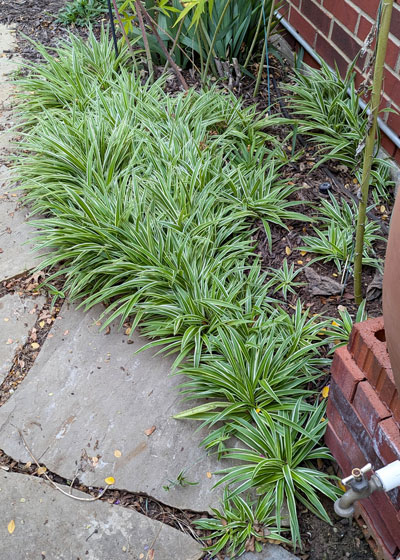
Answer: You have a lovely bed of the winter-hardy groundcover variegated liriope. Liriope muscari ‘Variegata.’
It should not be confused with the tropical spider plant (Chlorophyllum comosum ‘Variegatum’) about which I wrote here a week or two back. Remember that plants are classified based on their flowers and not on the looks of their leaves. These two plants are not related.
QUESTION 4
WHEN SHOULD LANDSCAPE FABRIC BE PUT DOWN?
Question: In earlier posts people asked about a pesky vine that looked similar to English ivy. Your solution has been to put down a layer of landscape fabric. When is the best time to do that so I can replant plants like skullcaps on top of the fabric? John R., Plano.
Answer: I would roll out the weed-blocking landscape fabric in late winter or very early spring. You want to get it in place before any of the snailseed vine and perennial morning glory relatives start to grow. As for the skullcaps and other perennials, you’re really not planting “on” the weed-blocking fabric. You would want to plant “through” it. Cut small slits and plant through them. Of course, that presumes that you’ve done a sensational job of working up the garden soil beforehand. You won’t need to leave the fabric in place more than a couple of years. I actually prefer not trying to grow my perennials through it. I just cover it with bark mulch and let the shrubs and container plants be my color and vegetable garden for that year or two. Once freed of the weedy vines I can remove the fabric and go back to doing whatever I want.
QUESTION 5
HOW LATE SHOULD I FERTILIZE MY BOUGAINVILLEA? ALSO MY CRAPE MYRTLES?
Question: How late should I be feeding my bougainvilleas and crape myrtles this fall? Betty D., Glen Rose.
Answer: You’re past the time. Unless I had a very warm greenhouse, I’d cut back on feeding bougainvilleas by the end of August. And early September for crape myrtles growing outdoors. You don’t want any new growth on either of those plants in the fall.
QUESTION 6
WHEN CAN I TRANSPLANT MY ANACACHO ORCHID TREES?
Question: I have three volunteer Anacacho orchid trees that I would like to transplant. How and when can I do that? Northern Hays County.
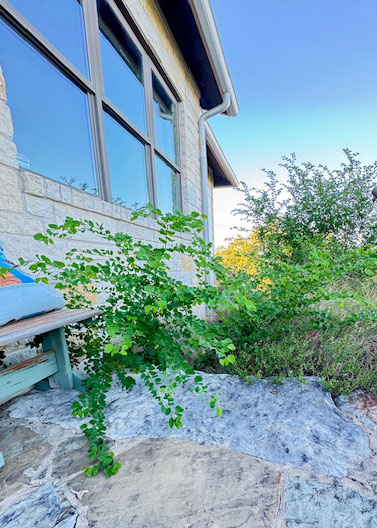
Answer: They are not terrifically winter hardy, so I would wait until most of the winter has passed. Early February. Dig them with a sharpshooter spade, getting as much of the root system with each of them as you can. Replant them immediately, setting them at the same depth at which they were growing originally. Water them deeply and hope for the best. Good luck with the transplanting.
QUESTION 7
WHAT SHOULD I DO WITH MY CHINQUAPIN OAK?
Question: A storm 8 days ago knocked the main trunk out of the top of our 20-year-old Chinquapin oak. The crown hasn’t been looking too good for several weeks. I wonder if the tree had been damaged by a storm back in May. This is the only tree on our one acre, and I want to save it. Should I call in an arborist? Claudia E., Rockwall.


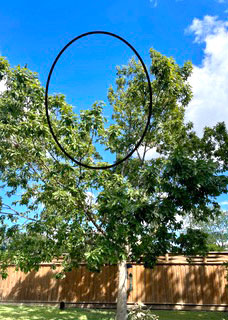
Answer: It’s hard to see the damage at the top of the tree, but it looks like old decay – older than just from May. I would definitely suggest having a certified arborist look at your tree. Our advertisers here in e-gardens are at the top of the tree service industry if you are looking for someone. You need a company that is insured and bonded because to climb that tree puts the climber at great risk. The trunk may not be stable at all. Good luck. I hope you can save it!
QUESTION 8
HOW CAN I ELIMINATE THE WHITE STUFF THAT IS KILLING MY HIBISCUS?
Question: I’ve had potted hibiscus on my deck every year for 20 summers. I’ve never seen this white stuff. I’ve fought it all summer. What is it, and how can I eliminate it? Clifford B., Cedar Park.
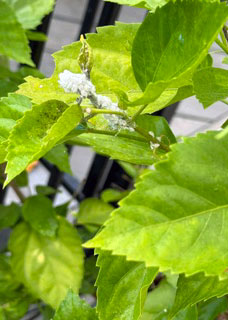
Answer: It looks like a pile-up of mealybugs. They’re soft-bodied scale insects that suck sap right out of the stems and leaves of many of our most prized plants. I usually start with cotton swabs dipped in rubbing alcohol and I wipe as many of them as I can off the stems and leaves. You have to send the swabs down into the axils of the leaves, because the small bugs will hide there. Be vigilant in controlling them because their populations will increase dramatically when you bring the plants indoors for the winter. Any natural predators will be left outdoors. You could also try one of the systemic insecticides as a soil drench but be forewarned that hibiscus plants are sensitive to several of our common insecticides. Read and follow label directions carefully.
QUESTION 9
WHAT HAPPENED TO MY PURPLE HYACINTH BEANS?
Question: Attached are photos of the purple hyacinth beans that we spoke about on the radio. Thanks for this opportunity to get them to you for analysis. What might have happened to them? Barbara K., Dallas.
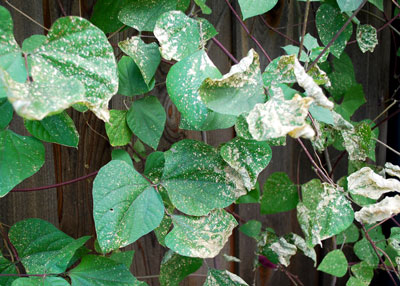
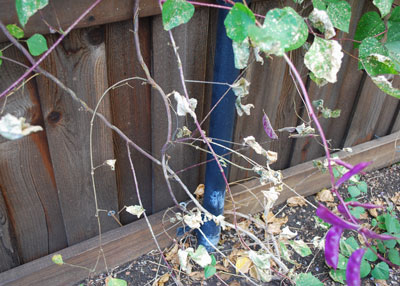
Answer: (To my other readers – when I reach an impasse in answering a question during one of my radio programs I invite the listener to send a photo to a special box we have set up for this purpose. But I also tell them that I will answer here in e-gardens so that anyone listening can have a chance to see my reply. Barbara was listening to my program last Saturday on KLIF.)
I saw the photo from the upper part of your plant first and I thought it looked like the leaves had been scalded by having water on them when the sun hit them back in the summer. But when I saw the photo of the lower portion of the plant it just shouted out of spider mites. I doubt if they will still be active, but when they are you can thump a leaf that is starting to turn tan over a sheet of white paper. Tiny specks will fall onto the paper, and if present, spider mites will start to move about freely across the surface of the paper. They are not as common on purple hyacinth beans (in my experience) as they are on green beans in the garden, but that may just be because you don’t see as many hyacinth beans out in landscapes. General-purpose insecticides that list mites should give fairly good control if you spray both tops and bottoms of the leaves at first signs of the fine mottling.
You also asked about saving the seeds. Some of your pods don’t look like they have filled out very well. Hopefully others have so that you will be able to let them mature naturally so that they can dry. If that fails, they are readily available on better quality seed racks and from many online seed sources.
QUESTION 10
SHOULD WE PRUNE OUR PEACH TREE, AND IF SO, WHEN AND WHERE?
Question: Thank you again for taking my call on Saturday. Attached is a photo of the Florida King peach tree we planted in April. Should it be pruned to do something with that one strong limb? If so, when and how? David and Cathy L., Spring.
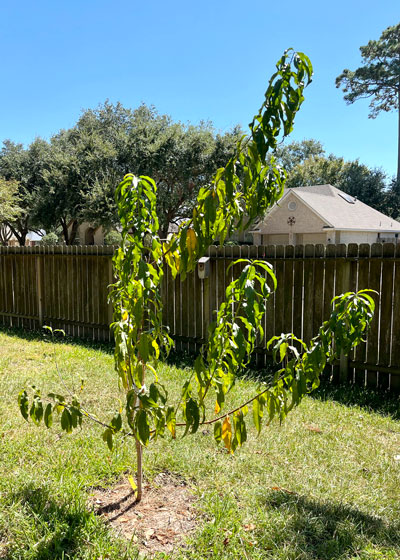
Answer: David called my statewide radio program that airs Saturday mornings 11-noon.
The photo helps a bunch! Yes, that limb needs to be trimmed way back.
In a perfect world, your goal with peaches (and plums) is to have three main scaffold branches 22 to 26 inches from the ground, offset by roughly 120 degrees, and not originating at the same height on the main trunk. As the tree develops you will want to remove all strongly vertical growth each winter so that it develops a sort of “cereal bowl” shape.
You’ll remember that I suggested waiting until winter to do this trimming. The tree isn’t going to grow much more yet this fall so you won’t be hurting it by waiting. Then you’ll be able to see things very plainly. It looks like you’ve gotten lucky in that the branches pretty well encircle the trunk.
I’m going to have to give you a rough estimate on the tall branch. If you look through the tree at the fence, you’ll see the shadow of the bottom cross rail. You will probably want to trim the tall branch back to slightly above the line of that bottom cross rail (way back) – not as high as halfway to the top rail. Similarly, you’ll probably want to trim the two branches coming off to the right back by 8 or 9 inches. You don’t want branches to drag the ground from the weight of their fruit, but you also don’t want to allow vertical shoots to develop. Each of those right-side branches has vertical shoots.
Here’s the deal I’ll suggest: Somewhere around January 1, stand exactly where you were standing when you took this photo at the same time of day and take us another photo of the bare tree. Send it as you did this one and I’ll put them both in e-gardens with a clearer answer of where you should prune. January would be the proper time, and I’d feel better about my answer.
